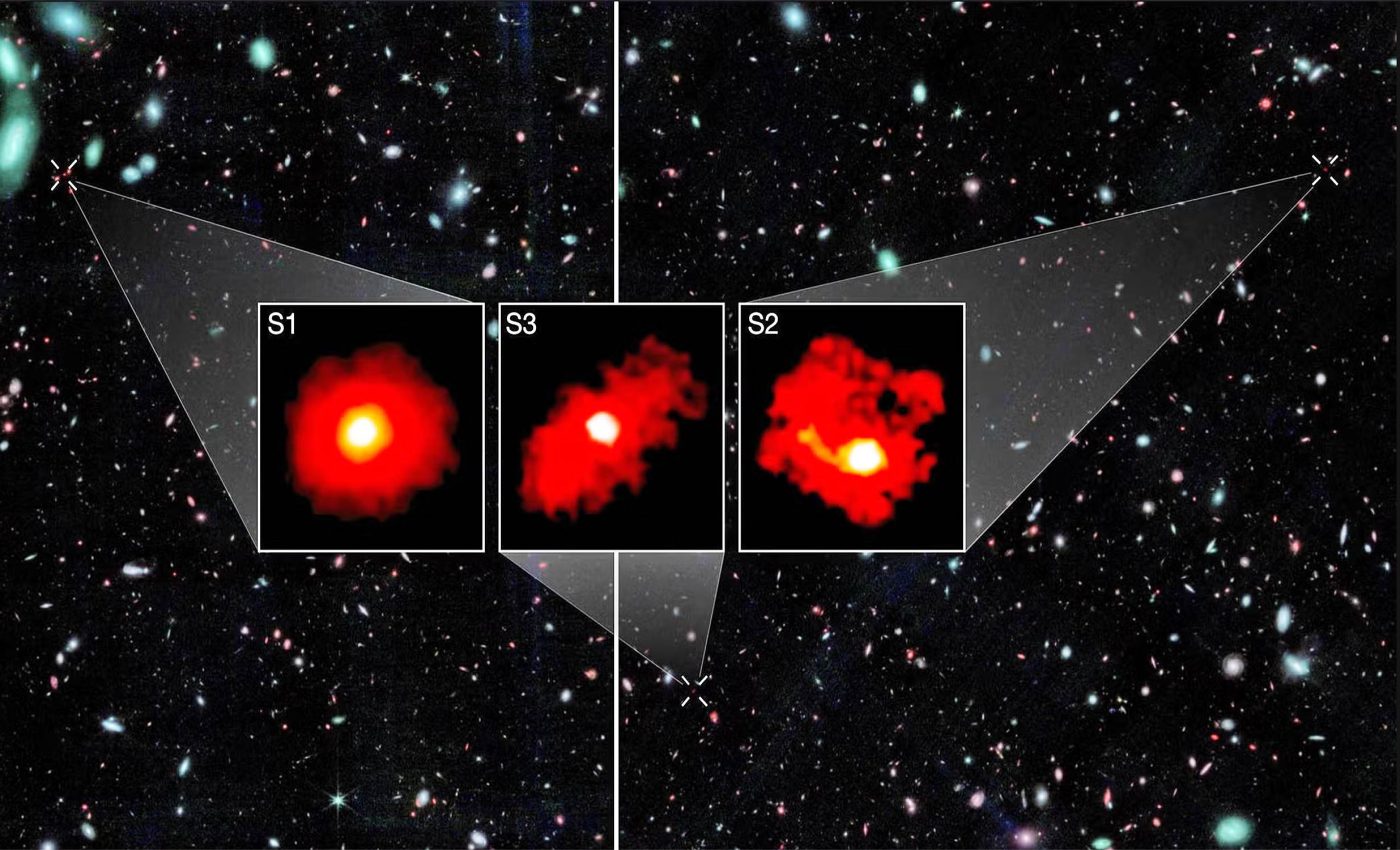
Three 'Red Monsters' discovered, scientists declare "beginning of a new era"
When the Webb Telescope began sending back its first deep‑field images, astronomers expected a gentle trickle of faint, infant galaxies. Instead, they found massive, bright “red monster” galaxies shining barely 500 million to one billion years after the Big Bang.
That early cosmic boom of redshifted galaxies surprised even seasoned researchers who thought they had a solid grip on how galaxies grow.
Those jumbo galaxies – some as hefty as today’s Milky Way – seemed to upend the standard Lambda Cold Dark Matter (ΛCDM) framework. After all, if giants showed up so soon, maybe the textbook timeline for star formation needed a fresh look.
To pin down what Webb had really seen, an international team dug into the telescope’s FRESCO survey, which pairs crisp imaging with spectroscopic measurements that reveal a galaxy’s exact distance and age.
Sky full of ‘red’ galaxies
Using FRESCO, the team sifted through 36 dust‑shrouded galaxies. Precise redshifts confirmed that most of them fit neatly within ΛCDM expectations.
Three objects, however, refused to play by the usual rules. Each one boasts a stellar mass greater than 10¹¹ times that of the Sun – impressive for any epoch, but absolutely astounding for the universe’s first billion years.
Together the galaxies may have fueled about 17 percent of all star formation between redshifts 5 and 6, when the cosmos was just under a billion years old.
Peering back 13 billion years
“Our findings are reshaping our understanding of galaxy formation in the early universe,” says Dr. Mengyuan Xiao, lead author of the study from the University of Geneva.
The trio’s extreme efficiency stands out: they appear to have turned roughly half of the normal matter available inside their dark‑matter halos into stars, two to three times the rate seen in later epochs.
Typical galaxies manage no more than 20 percent. Yet the emission from these early behemoths is spread across each system, hinting that a ravenous central black hole is not the main driver.
“Red monster” galaxies emerge
High dust content reddens these galaxies in the Webb Telescope’s near‑infrared view, earning them the nickname “red monsters.”
“The massive properties of these ‘red monsters’ had hardly been determined before JWST because they are optically invisible owing to dust attenuation,” explained Dr. David Elbaz of CEA Paris‑Saclay.
That veil once hid their true size from earlier telescopes that relied on ultraviolet light, which dust readily absorbs.
Webb’s NIRCam/grism setup changes the game, catching the faint glow of star‑forming regions even when soot‑like grains block shorter wavelengths.

“Our findings highlight the remarkable power of NIRCam/grism spectroscopy,” explains Pascal Oesch, principal investigator of the program.
“The instrument on board the space telescope allows us to identify and study the growth of galaxies over time and to obtain a clearer picture of how stellar mass accumulates over the course of cosmic history.”
New rules for the early universe
The ΛCDM model says dark‑matter halos act as cosmic scaffolding, snagging gas that later cools and condenses into stars. Over billions of years, most galaxies never convert more than a fifth of that gas.
The red monsters push that limit hard. Forming stars nearly twice as efficiently as smaller systems of the same era, they hint that early conditions – higher gas densities, faster cooling, or more frequent mergers – offered shortcuts to rapid growth.
“These results indicate that galaxies in the early universe could form stars with unexpected efficiency,” Dr. Xiao concludes.
“As we study these galaxies in more depth, they will offer new insights into the conditions that shaped the universe’s earliest epochs. The red monsters are just the beginning of a new era in our exploration of the early universe.”
Why do red monster galaxies matter?
Because light takes time to travel, Webb’s mirrors act like a time machine. Looking 13 billion light‑years away means seeing the cosmos as it was 13 billion years ago.
Catching massive galaxies so soon after the Big Bang forces theorists to revisit the ingredients in their simulations.
Did early gas clouds cool faster? Did primordial stars explode in ways that seeded galaxies with heavy elements sooner than thought? Or do current models underestimate how quickly halos pull matter together at high redshift?
While the latest measurements leave ΛCDM standing, they shrink its wiggle room. Galaxy‑formation codes must now reproduce both the typical dust‑rich galaxies and these overachievers without breaking other well‑tested predictions, such as the distribution of the cosmic microwave background.
What happens next?
Future Webb programs will broaden the census of early massive systems, while the Atacama Large Millimeter/submillimeter Array (ALMA) maps cold gas and dust in finer detail.
Together they can show whether the red monsters are rare oddities or signposts of a busier‑than‑expected era.
If more turn up, theorists may need to refine how feedback from newborn stars and nascent black holes regulates star formation when the universe is young, dense, and eager to shine.
For now, the trio of red monsters stands as a reminder that the cosmos still holds plenty of secrets. Webb’s sharp eyes and spectroscopic tools have opened a fresh window on those first luminous giants.
As astronomers peel back more layers, they’re likely to find that the universe’s childhood was livelier – and more efficient – than anyone guessed.
—–
The full study was published in the journal Nature.
Featured Image Credit: NASA / CSA / ESA / M. Xiao & P. A. Oesch / G. Brammer / Dawn JWST Archive
—–
Like what you read? Subscribe to our newsletter for engaging articles, exclusive content, and the latest updates.
Check us out on EarthSnap, a free app brought to you by Eric Ralls and Earth.com.
—–













